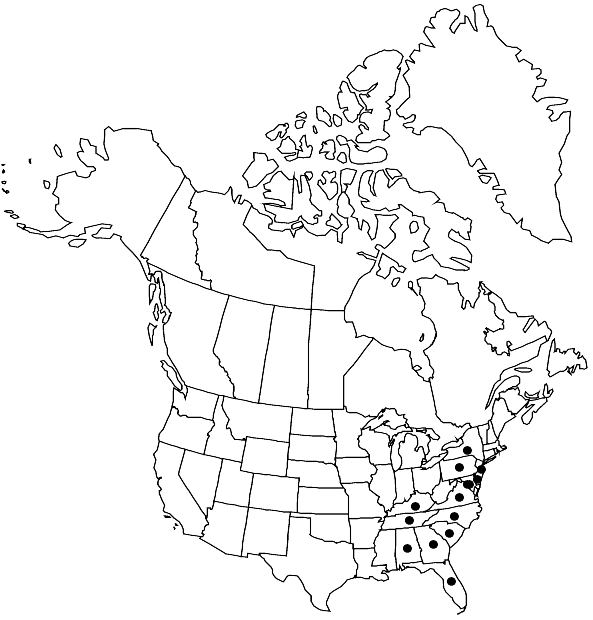Difference between revisions of "Sphagnum tenerum"
in A. Gray, Manual ed. 2, 611. 1856,.
FNA>Volume Importer |
FNA>Volume Importer |
||
| Line 10: | Line 10: | ||
|name=Sphagnum capillaceum var. tenerum | |name=Sphagnum capillaceum var. tenerum | ||
|authority=(Sullivant) H. A. Crum | |authority=(Sullivant) H. A. Crum | ||
| − | }}{{Treatment/ID/Synonym | + | }} {{Treatment/ID/Synonym |
|name=Sphagnum capillifolium var. tenerum | |name=Sphagnum capillifolium var. tenerum | ||
|authority=(Sullivant) H. A. Crum | |authority=(Sullivant) H. A. Crum | ||
| − | }}{{Treatment/ID/Synonym | + | }} {{Treatment/ID/Synonym |
|name=Sphagnum tenerum var. virginicum | |name=Sphagnum tenerum var. virginicum | ||
|authority=H.A. Crum & L. E. Anderson | |authority=H.A. Crum & L. E. Anderson | ||
| Line 30: | Line 30: | ||
|elevation=low to moderate elevations | |elevation=low to moderate elevations | ||
|distribution=Ala.;Del.;D.C.;Fla.;Ga.;Ky.;Md.;N.J.;N.Y.;N.C.;Pa.;R.I.;S.C.;Tenn.;Va. | |distribution=Ala.;Del.;D.C.;Fla.;Ga.;Ky.;Md.;N.J.;N.Y.;N.C.;Pa.;R.I.;S.C.;Tenn.;Va. | ||
| − | |discussion=<p>Sporophytes are uncommon in Spagnum tenerum. The sexual condition is uncertain because of past taxonomic confusion with S. capillifolium (R. E. Andrus 1980). Sphagnum tenerum is usually described (incorrectly) as having hemiisophyllous stem leaves, and many collections of other species of sect. Acutifolia with such leaves have been called S. tenerum. When correctly characterized, S. tenerum is can be confused only with S. capillifolium, with which it has only a very small range overlap. Microscopically, besides the otherwise quite different S. angermanicum, S. tenerum is the only species of sect. Acutifolia with large round free pores in most of the branch leaf hyaline cells on their concave surfaces. See also discussion under 71. S. capillifolium. Sexual condition and spore features were taken from H. A. Crum (1984).</p><!-- | + | |discussion=<p>Sporophytes are uncommon in Spagnum tenerum. The sexual condition is uncertain because of past taxonomic confusion with <i>S. capillifolium</i> (R. E. Andrus 1980). <i>Sphagnum tenerum</i> is usually described (incorrectly) as having hemiisophyllous stem leaves, and many collections of other species of sect. Acutifolia with such leaves have been called <i>S. tenerum</i>. When correctly characterized, <i>S. tenerum</i> is can be confused only with <i>S. capillifolium</i>, with which it has only a very small range overlap. Microscopically, besides the otherwise quite different <i>S. angermanicum</i>, <i>S. tenerum</i> is the only species of sect. Acutifolia with large round free pores in most of the branch leaf hyaline cells on their concave surfaces. See also discussion under 71. <i>S. capillifolium</i>. Sexual condition and spore features were taken from H. A. Crum (1984).</p><!-- |
| − | --><p>The name Sphagnum evansii Warnstorf has also been used for this taxon.</p> | + | --><p>The name <i>Sphagnum</i> evansii Warnstorf has also been used for this taxon.</p> |
|tables= | |tables= | ||
|references= | |references= | ||
| Line 54: | Line 54: | ||
|publication year= | |publication year= | ||
|special status= | |special status= | ||
| − | |source xml=https://jpend@bitbucket.org/aafc-mbb/fna-data-curation.git/src/ | + | |source xml=https://jpend@bitbucket.org/aafc-mbb/fna-data-curation.git/src/8f726806613d60c220dc4493de13607dd3150896/coarse_grained_fna_xml/V27/V27_106.xml |
|genus=Sphagnum | |genus=Sphagnum | ||
|section=Sphagnum sect. Acutifolia | |section=Sphagnum sect. Acutifolia | ||
Revision as of 17:52, 18 September 2019
Plants ± robust, weak-stemmed, and compact, capitulum hemispherical, branches in capitulum short and blunt; typically mottled pale yellow-green and purplish red, without metallic sheen when dry. Stems pale yellow-green to pink; superficial cortical cells nearly always aporose. Stem leaves 1.4–1.8 mm, elongate-triangular, lingulate-triangular, hemiisophyllous forms elongate triangular-ovate, 1.4–1.8 mm, apex usually conspicuously toothed, border narrow at base (less than 0.25 width); hyaline cells narrowly rhombic to S-shaped, can be efibrillose and aporose but more commonly fibrillose and porose, 0–1-septate. Branches turgid and terete, leaves, not 5-ranked. Branch fascicles with 2 spreading and 1–2 pendent branches. Branch leaves ovate, 1.1–1.7 mm, slightly concave, straight, apex weakly involute and conspicuously toothed; hyaline cells on the convex surface with round to elliptic pores along the commissures, grading from moderate-sized pores near apex to large pores at leaf base, concave surface with large round pores throughout. Sexual condition uncertain, monoicous or dioicous or possibly both. Spores 22–25 µm, finely roughened.
Habitat: Damp sand and thin humus especially around pond margins, open savannas, and pine barrens
Elevation: low to moderate elevations
Distribution

Ala., Del., D.C., Fla., Ga., Ky., Md., N.J., N.Y., N.C., Pa., R.I., S.C., Tenn., Va.
Discussion
Sporophytes are uncommon in Spagnum tenerum. The sexual condition is uncertain because of past taxonomic confusion with S. capillifolium (R. E. Andrus 1980). Sphagnum tenerum is usually described (incorrectly) as having hemiisophyllous stem leaves, and many collections of other species of sect. Acutifolia with such leaves have been called S. tenerum. When correctly characterized, S. tenerum is can be confused only with S. capillifolium, with which it has only a very small range overlap. Microscopically, besides the otherwise quite different S. angermanicum, S. tenerum is the only species of sect. Acutifolia with large round free pores in most of the branch leaf hyaline cells on their concave surfaces. See also discussion under 71. S. capillifolium. Sexual condition and spore features were taken from H. A. Crum (1984).
The name Sphagnum evansii Warnstorf has also been used for this taxon.
Selected References
None.